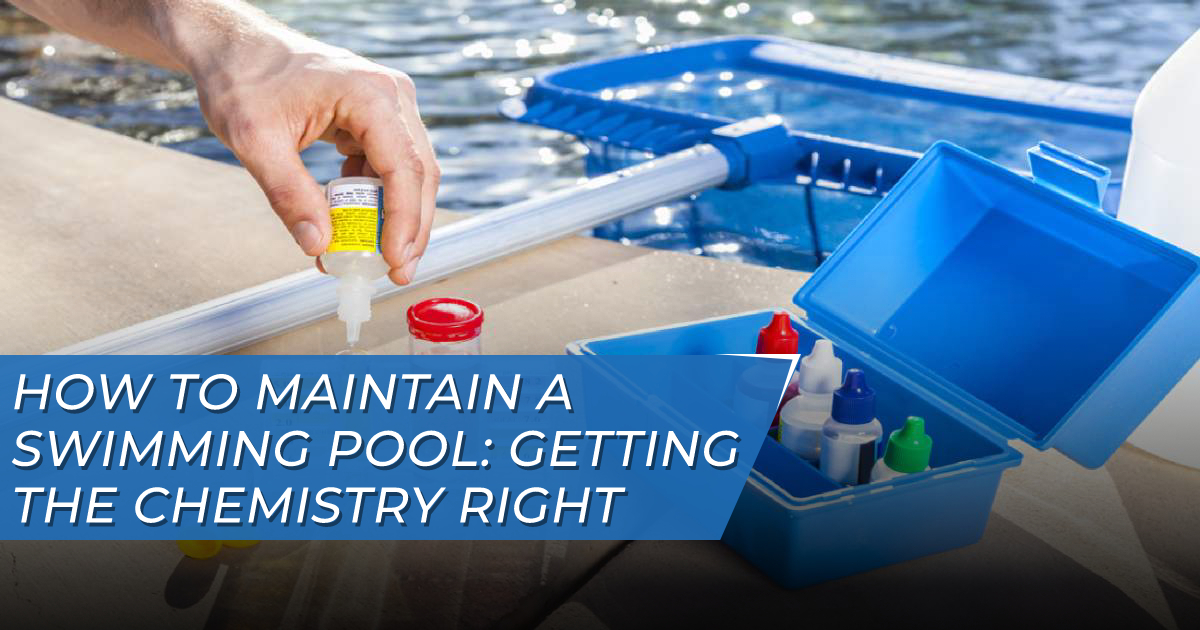How to Maintain a Swimming Pool: Getting the Chemistry Right
Crystal clear water makes a pool or spa enjoyable and inviting. Getting the pool in great condition and keeping it that way will require some knowledge about how to maintain a swimming pool. The basic steps to maintain a swimming pool consist of cleaning, testing, and adding the right chemicals.
The reason that owners must learn how to maintain a pool is that the water has a delicate balance. Pool chemicals react to heat and sunlight. The UV rays of the sun cause pool chemicals to break down and burn up. For example, many chemicals must be added at sundown or at night for maximum benefit. It is important to notice ‘ when’ to add chemicals as well as ‘how much?’ and ‘how often?’
Pool chemistry has two basic parts. First is the water balance of the chemicals to keep the water in the neutral zone. The second phase is the cleanliness or water sanitation process that gets rid of harmful compounds, bacteria, and microbes.
Related Article: Swimming Pool Chemicals for Beginners
Water balance: How is it determined and done?
 Pool water constantly changes with air, sunlight, and the filtering action of the pump. Nearly everything that contacts the water helps make some type of change including air pollution, oils from the skin, perfumes, and cosmetics. To get the water in the correct chemical balance the pool water must have a pH measurement between 7.4 and 7.6. Testing is the best way to discover the condition of the water.
Pool water constantly changes with air, sunlight, and the filtering action of the pump. Nearly everything that contacts the water helps make some type of change including air pollution, oils from the skin, perfumes, and cosmetics. To get the water in the correct chemical balance the pool water must have a pH measurement between 7.4 and 7.6. Testing is the best way to discover the condition of the water.
The pH Factor
Level: the correct pH range is 7.4-7.6
The percentage of hydrogen or pH is the measure of the water’s chemical balance. On the low end of the scale is the acid range and on the other end is the caustic or basic range. Water at either end of the range is unhealthy and harmful. The ideal range is in the middle of the scale – in the number 7 range- halfway between the acid side and the caustic side. For example, a human tear is between 7.0 and 7.2 on the pH scale.
Alkalinity
Level: the proper level is 100 to 150 PPM (parts per million)
Alkalinity keeps the pH in the safe range by absorbing some water changes before that can change the pH. A good supply of alkalinity increaser will help adjust to changes over time.
Calcium or Hardness
Level: the calcium hardness level should be between 200 to 275 parts per million IF NEEDED.
Owners should measure at the start of the season or at fill-up and check after that. Calcium is important to protect plaster pool surfaces so that the water will not absorb calcium from the pool surface.
How to Maintain a Swimming Pool – Keeping Water Balanced
Owners must test the pH with test strips or a pH testing kit. They should test pH often, a few times per day if needed. When the water pH stabilizes and yields consistent 7.4-7.6 ratings, then one can test less often. When the pH is low, owners must add a pH increaser. The pool pH can change quickly, and they should keep a good supply of pH increaser on hand.
The typical pool season uses the below-listed chemicals in a large supply
- pH Increaser
- pH Reducer
- Alkalinity Increaser
Water testing kits can yield five results to measure Chlorine, Bromine, pH, Acid Demand, and Total Alkalinity. Pool owners must keep the pool water balanced and clean. Balancing is a matter of getting the right combination of chemicals in the water.
Related Article: Cheap Pool Chemicals: Does it Matter Which Brands You Use?
Pool shock, and other chemical treatments. What chemicals go into your pool and why?
Pool shock is a necessary process that involves putting large amounts of chemicals in the water. Shock is needed because the chlorine in the pool water combines with ammonia that comes from skin oils, sweat, and body fluids. The chlorine absorbs these materials and forms odorous compounds called Chloramines. The strong chlorine odor in some pools comes from chloramines. Water with excessive chloramines can irritate the skin eyes and nostrils. Shocking the pool water adds enough chlorine to break up the chloramines and destroy the buildup.
Properly balanced pool water makes the sanitation process work much better than when the water is out of balance. Proper water balanced water adds safety.
Related Article: Pool Shock Guide: What it is and How to Use it
Pool Sanitation and Pool Safety
The need for pool sanitation cannot be overstated. Pool water absorbs body sweat, lotions, and other body fluids from swimmers. Pools lose water through evaporation, and it must be replaced with fresh water. Most pools get a complete refill in about 100 days. The chlorine and other disinfectants perform a vital task. However, the pool cleansing chemicals form compounds with human sweat, personal products, and other body fluids. These compounds can form breeding grounds for disease-causing microbes and may be health hazards through long or frequent exposures.
- Chlorine
The proper chlorine level is 3ppm( three parts chlorine per million parts of water)
The best pool sanitizer is chlorine. It works on contaminants and bonds with them. The shock can cleanse the water of used chlorine. The below-listed items are chlorine alternative sanitizers.
- Bromine: a close chemical to chlorine
- Biguanide: Baquacil or the trade-name SoftSwim
- Minerals: silver and copper
Use Shock to Maintain a Pool
Shock is the method for adding a large amount of chlorine to a pool. The usual amount of chlorine protects the pool by combining it with contaminants. After a period, the chlorine is used up by combining with contaminants. The water may look clouded or give off a strong odor of chlorine. Shock raises the level of chlorine by 10 ppm over the existing combined chlorine reading. The powerful blast of fresh chlorine eats the used chlorine by breaking up the bonds and letting it burn up.
- Shock at Night
The shock chemical will burn up quickly in the UV rays of the sun. Owners should apply shock at dusk or nighttime. The darkness helps the shock work and leaves the water safe and clean. Owners can apply shock about once per week.
Pool cleaning: How to do proper pool cleaning and maintenance
Once a pool is filled, balanced, and sanitized, the next order of pool maintenance is cleaning. Depending on the season, the pool can get a regular dose of windblown leaves, thirsty insects, dust, and soil. The bottom can hold debris along with the walls. The filter and skimmer will take a good number of larger objects, but there will always be some need for pool cleaning. When deciding how to maintain a pool, cleaning options range from manual scrubbing to automatic pool cleaning systems. Many owners contact a reliable local pool maintenance service for all their pool water and cleaning needs.
Related Article: Robotic Pool Cleaners: What Are The Benefits?
How to maintain a swimming pool– Finishing Tips
The basics of pool maintenance are pH, alkaline, calcium, shock, and a sanitizing chemical. With regular care, the water will feel refreshing and have a clear and sparkling appearance. Some additional points offer tips on algae and stabilizers.
- Water Stabilizers help protect chlorine which can get burned off by the UV rays of the sun. Water stabilizers are particularly helpful when starting the pool with fresh water.
- An Algaecide is a chemical that can prevent algae from forming in the pool water. For most pool owners Chlorine is the best algae killer. An algaecide can help control algae during times when the chlorine levels may be too low.
- Alkalinity decreasers are not generally available. When pH is too high, the pH decreaser will reduce both pH and alkalinity. High alkalinity and low pH must be addressed by first lowering alkalinity with a pH decreaser and then gradually raising both pH and alkalinity.
Related Article: Proper Water Balance and Testing
Quality Supplies and Pool Service
Proper water balance and pool maintenance can make your pool welcome and inviting to you, your family, and your guests. Call or visit us when you need supplies, pool equipment repairs, replacements, or advice to maintain a pool. We have expert staff ready and eager to answer your questions and help keep your pool looking great. We offer high-quality full-service water balancing and pool maintenance. Call us, the expert pool supply and service provider serving New Tampa, Lutz, Land O’ Lakes, and surrounding areas.

